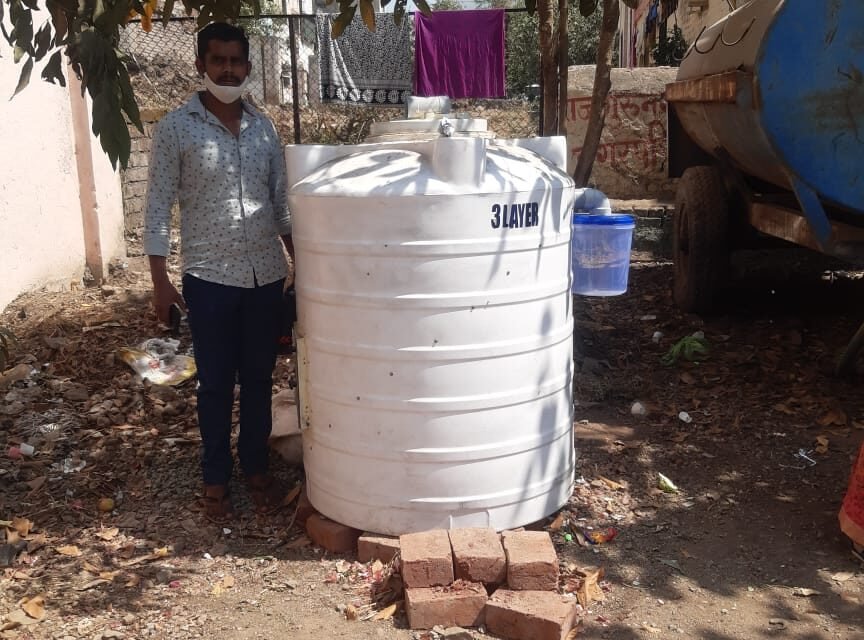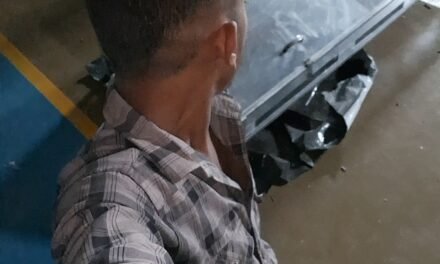Introduction
Rajgurunagar Municipal Council, Pune purchased two wet waste management units from E&P Community Farms, Khed. They installed those units nearby the vegetable market of Rajgurunagar. These systems were installed to manage the wet waste collected from the vegetable market of Rajgurunagar. E&P Community Farms claimed some performance abilities of the system. Rajgurunagar Municipal Council contacted Vigyan Ashram, Pabal to test the systems and verify the claims of the E&P Community Farms. Vigyan Ashram gave me this opportunity to test the systems and verify the claims as a case study for my final year internship.
Each tank has a 1000 litre capacity. It was supposed to load 100 kgs of wet waste daily into the tanks. Larvae of black solder flier were supposed to consume the wet waste and convert it into Leached. Eventually, this leached will become fertilizer. Grown larvae will be used as poultry feed and further farming of black soldier fly.
The E&P Community Farms company claims are as follows:
1) One unit processes 100kg of organic waste at one site in one day.
2) Other composters do not produce high-quality compost and the price of compost is high.
3) Our system is society friendly and takes up less space, it can be placed anywhere on the roof.
4) Our system does not require any operation.
5) They say that what is leached from it is suitable for agriculture and we sell it for 450INR.
The Black Soldier Fly, Hermetia illucens, is of the dipteran family Stratiomyidae. The larvae and adults are considered neither pests nor vectors. Instead, black soldier fly larvae play a similar role to that of redworm as essential decomposers in breaking down organic substrates and returning nutrients to the soil. The larvae have voracious appetites and can be used for composting household food scrap and agriculture waste products. Additionally, black soldier fly larvae (BSFL) are an alternative source of protein for aquaculture, animal feed, pet food and human nutrition
Hand Sketch Diagram

Need of project
1. In the drum system check larvae can service and grow in the claimed system
2. Check reduction in volume and possibly in weight as larvae will consume waste as their food.
3. Check & observe system set up by E&P Community Farms. Keep a daily records with respect to harvest Black
Soldier larvae & effective composing of waste garbage.
Objectives
- To observe the Black Soldier Fly unit installed by E & P Community Farms at Rajgurunagar Nagar Perished.
2. To study the Black Soldier Fly technique for wet waste management and submit suggestions and conclusions to Rajgurunagar Parishad.
Data Sheet:-
Auto CAD 2D design:-

Process Flow Diagram

Observation
23 Feb
E and P Community Farms has set up two systems in the vegetable market near Rajgurunagar Municipal Council. That system was two tanks of 1000 litres. There was a special layer at the bottom of the tank but we couldn’t see it because it was full of garbage. From the bottom of the tank to the top. A semi-flexible pipe was wrapped around the inside of the tank. The top end was attached to the bucket used for collecting larvae.


Tank 1 was filled with garbage and tank 2 was half-filled and filled in the garbage tank without weighing. The information we received was 20 grams of black soldier larvae were engaged into tanks 1 and 2. There were lots of smells, flies and Gnats.
26 Feb
The waste in both the tanks did not rot and no larvae were seen and the colour of the waste did not change. There was a lot of smell, there were flies.
28 Feb
When the supervisor madam came to inspected, we asked her how much garbage was loaded? she said no garbage for 10 days. Tank 1 showed larvae and tank 2 did not show larvae. But different types of insects were seen in the tanks. The traders had complained to the city council that the valve in tank 1 had damaged due to vandalism and leachate was leaking .
01 Mar
The waste in the tanks did not look rotten, the larvae in tank 1 very noted gaining weight and no larvae could be spotted in in tank 2. Foul smell, files and other insects were prominent observations .
02 Mar
The bucket on the side of tank 1 was missing. There was a lot of smell coming from the hole used to attach the bucket. So no waste was dumped in both the tanks. The valve was leaking and smelling bad.

03 Mar
Both tanks were filled with garbage, larvae were not visible in tank 2. There were larvae in tank 1. The stench was coming from both the tanks and flies were observed in the tanks. We could not get any information about amount of garbage charged.

04 Mar

Both tanks were filled with garbage but we failed to get any quantitively estimate of load. The waste from the glass in the center of the tank appeared to be shrinking may be due to the anaerobic process. The larvae in tank 1 have grown and their size has also increased, but in tank 2 lower number was noted. The tank was leaking due to lack of repairs of the valves. The system was covered with jute to reduce the temperature of the tanks.
05 Mar
The tanks were filled with garbage but the garbage was not being weighed. The traders had lodged a complaint with the city council for fear of spreading the disease.
07 Mar
The tanks were filled with garbage again but the weight of the rubbish mentioned by Madame was different from the weight of the rubbish reported by a security grad working on site. They put back leached in the tank . The larvae were less visible in both the tanks. Adult larvae were dying due high temperatures because the bucket for collection were missing.

08 Mar
Replacing the valve and bucket stopped the leak, but the stench was evident.
09 Mar
The amount of garbage loaded were hyped( my impression). She also put the larvae from bucket were charged back to in the tank. The stench continued from the valves were loosely fitted and hence disappearance, the quantity of flies in the vegetable market was increasing, so traders were demanding to relocate the system.
10 Mar
They stopped dumping garbage into the system and the system has less larvae and more garbage so the garbage became anaerobic, resulting in bad smell.
11 Mar
The level of waste in the tanks looked the same. 10 to 12 larvae were seen in both the buckets. As the stench increased, they stopped filling the tanks with garbage. Flies and gnats were seen.

12 Mar
The larvae in the outer bucket were thrown into the tank. The T-joint attached to the tank lid was missing, giving off a foul odor.
13 Mar to 22 Mar
The T joints, buckets and valves on the lid were not fitted properly and they were stolen at night. The system was completely shut down by placing a plastic bag on the openings and the system will be kept closed till the safe compound is established, said the supervisor Madam.
25 Mar
The city council compounded to secure the system.

13 April
Since the system was completely shut down, they did not have an automated system to remove the garbage inside, so they took out the garbage with the help of people and filled the bag, so there was a lot of smell. The traders were saying that the man who had come to collect the garbage had fallen ill.

Conclusion:-
In such a system waste is not composted and very strong foul smell indicated that it has become anaerobic.
Such a system is not suitable for waste management.
Half cooked technology and falls claims seems to be the exiting condition of waste management at least at Rajgurunagar which is just 40 km from Pune and on Pune Nashik Highway.
Future plan
I plan to take up a small project for bereding of Black soldier fly at Vigyan ashram
16 May
Ranjit Sir, Dixit Sir, Rohit and I discussed the BSF system in Vigyan Ashram.
It was decided to dispose of 300 kg of waste and that waste will require 100 kg of kitchen waste 3 times every 4 days. The larvae need an intake temperature of 37 °
The list of materials required for the system is as follows
- Tray
- Shed net
- Rack
To prepare the feed for the larvae, add 600 g of chicken feed and 1500 liters of water to the tray and prepare the feed.
17 May
Place the sieve upside down in the prepared feed and place 10 gm eggs on it.


20 May
Note
Due to increase in temperature the larvae died
29 May
After discussion with sir we select the percentage of azolla & kitchen waste which is added in
70 gm of BSR larvae added in each tray.
| Tray No | Azolla | Kitchen waste |
| A1,A2 | 50% | 50% |
| B1,B2 | 75% | 25% |
| C1,C2 | 25% | 75% |
| D1 | – | 100% |
| E1 | 100% (Grind) | – |
| F1 | 100% | – |
Starting material fill in a tray
| Tray No | Azolla | Kitchen waste |
| A1,A2 | 500 gm | 500 gm |
| B1,B2 | 750 gm | 250 gm |
| C1,C2 | 250 gm | 750 gm |
| D1 | – | 1000 gm |
| E1 | 1000 gm (Grind) | – |
| F1 | 1000 gm | – |
30 May
Addition of kitchen waste and azolla in trays
| Tray No | Azolla | Kitchen waste |
| A1,A2 | 500 gm | 500 gm |
| B1,B2 | 750 gm | 250 gm |
| C1,C2 | 250 gm | 750 gm |
| D1 | – | 1000 gm |
| E1 | 1000 gm(Grind) | – |
| F1 | 1000 gm | – |
2 Jun
Addition of kitchen waste and azolla in trays
| Tray No | Azolla | Kitchen waste |
| A1,A2 | 500 gm | 500 gm |
| B1,B2 | 750 gm | 250 gm |
| C1,C2 | 250 gm | 750 gm |
| D1 | – | 1000 gm |
| E1 | 1000 gm(Grind) | – |
| F1 | 1000 gm | – |
Daily Observation
This project was hand over to Ganesh & Javed.
CONCLUDING NOTE:-




